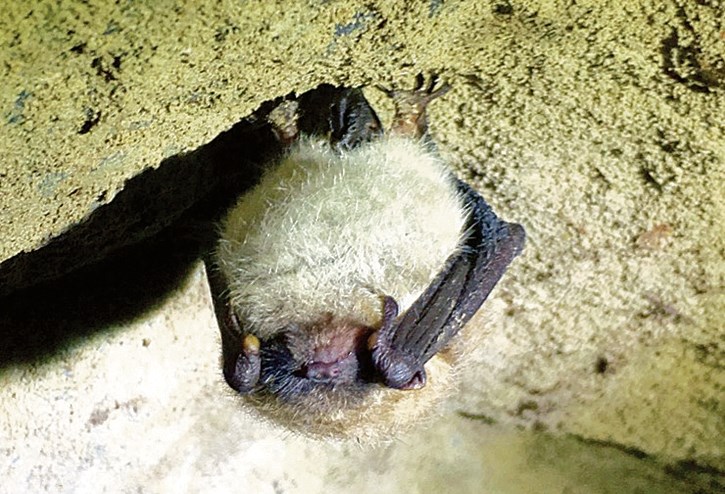As deadly white-nose syndrome continues to kill off bats in North America, Parks Canada is getting prepared for the inevitable westward spread of the deadly disease.
Last month, the federal agency and a team of researchers captured bats in mist nets and used recording devices to pick up bat calls in Kootenay National Park, leading to the identification of six bat species, including the endangered little brown bat.
“When white-nose syndrome was discovered, we realized we don’t know a lot about which species we have and where,” said Anne Forshner, a wildlife ecologist with Parks Canada.
“White-nose syndrome being discovered was the catalyst for us to collect inventory to be used in the future for conservation and recovery efforts,” she added, noting there are no signs yet of the deadly bat disease in the national parks.
In early July, Parks Canada teamed up with volunteers and bat researchers from the Alberta and British Columbia Community Bat Programs, the Ktunaxa Nation Council and University of Calgary to inventory bats in Kootenay National Park.
Researchers went looking for bats in different areas given different bats have different habitat requirements. They had most success at a watering hole in Kootenay National Park.
Along with the endangered little brown bat, long-eared myotis, long-legged myotis, big brown myotis, little brown bat, silver-haired bat and one hoary bat was identified. Of 31 captured bats, seven were little brown bats.
A small DNA sample was taken from bat wings to be used in a broader genetic study.
“We were interested in whether or not we might get California myotis, but we didn’t capture that species,” said Forshner, noting that species was identified back in an acoustic survey in 1983.
White-nose syndrome, which is caused by the fungus pseudogymnoascus destructans (Pd), is responsible for the deaths of millions of bats in the United States and Canada since its discovery in New York State in 2006.
The deadly disease affects bats during hibernation, causing them to awaken often and use up fat reserves they need to survive winter. They may also emerge from hibernation too early and starve or freeze to death.
The disease was confirmed in Washington State last year – the only western area so far – highlighting the importance of monitoring bat movement routes between the western and eastern sides of the Rockies.
Lizelle Odendaal, a post-doctoral researcher at the University of Calgary, said one of the concerns in Alberta is the lack of knowledge on where bats are hibernating, noting they also don’t have a good idea of where they’re coming from and where they’re going.
She said her research includes catching bats to compare genetic structure with other bat populations.
“We can look at DNA and look how dissimilar or similar bat populations are, and we can get an idea of their movements patterns. That’s important because we can then predict the spread of white-nose,” said Odendaal.
“By knowing in which direction bats are moving, which populations are sharing individuals, that will be a good idea of how the disease could spread. We need to try to get ahead of white-nose syndrome. It’s definitely coming, it’s just a matter of time.”
The capture of one hoary bat – one of North America’s largest bats at five inches in length and one of the most recognizable with its rich colouring – was somewhat of a surprise.
“That is a migratory species, so we don’t often catch them,” said Odendaal. “They fly very high above the canopy, so that’s definitely a really important find.”
A big focus is also put on the little brown bat, particularly because it’s an endangered species and it’s known to transfer the disease.
“There are other species, but then they might not be very good vectors of the disease if they don’t travel great distances,” said Odendaal.
“If you look at genetics and if populations are isolated, the chances of spreading it is low, but in little brown bats that move across mountain ranges, it could be high.”
Parks Canada is also trying to identify maternity roosts, where female bats gather to have their babies for several weeks in summer.
Forshner said a couple of maternity roosts for long-eared myotis have been found in picnic shelters – in Kootenay National Park and little brown bat in Banff National Park. The picnic shelter where little brown bats have been found has been closed.
“We’re working on a long-term plan of what we might do for that particular shelter,” she said. “It might include things like little bat boxes to see if they move on their own, but this is still initial and preliminary.”
There could also be eastern red bats in Banff and Yoho National Parks.
This bat species is found most commonly in the southern and eastern United States and in eastern Canada as far west as Saskatchewan. Until recently, the eastern red bat was considered an infrequent visitor to Alberta.
According to Alberta Environment and Parks, however, eastern red bats have been heard on bat detectors and captured during bat inventory projects in Alberta more frequently in recent years.
“Some information from Banff and Yoho that suggests we might have them,” said Forshner, but noted acoustics can have errors.




